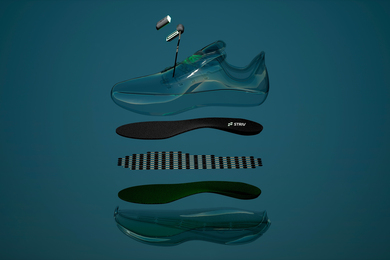- Contact Us
- Client Portal
- Go To CreatoLabs™Coming Soon!

The Olympics is all about pushing the frontiers of human performance. As some athletes prepared for the Paris 2024 games, that included using a new technology developed at MIT.nano.
The technology was created by Striv (pronounced “strive”), a startup whose founder gained access to the cutting-edge labs and fabrication equipment at MIT.nano as part of the START.nano accelerator program. Striv’s tactile sensing technology fits into the inserts of shoes and, when combined with algorithms that crunch that tactile data, can precisely track force, movement, and form. Runners including USA marathoner Clayton Young, Jamaican track and field Olympian Damar Forbes, and former Olympic marathoner Jake Riley have tried Striv’s device.
“I’m excited about the potential of Striv’s technology,” Riley says. “It’s on a good path to revolutionize how we train and prevent injuries. After testing the sensors and seeing the data firsthand, I’m convinced of its value.”
For Striv founder Axl Chen, the 2024 games are the perfect opportunity to show that the product can help athletes at the highest level. But Chen also believes their product can help many non-Olympians.
“We think the Paris 2024 Olympics will be a really interesting opportunity for us to test the product with the athletes training for it,” Chen says. “After that, we’ll offer this to the general public to help everyone get the same kind of support and coaching advice as professional athletes.”
Putting yourself in someone else’s shoes
Chen was working in a robotics lab at Tsinghua University in China when he began using tactile sensors. Over the next two years, he experimented with ways to make the sensors more flexible and cost-effective.
“I think a lot of people have already explored vision and language, but tactile sensing as a way of perceiving the world seemed more open to me,” Chen says. “I thought tactile sensors and AI could make for powerful new products.”
The first space Striv entered was virtual reality (VR) gaming. The company created a shoe with embedded sensors that could capture users’ body motions in real-time by combining the sensor data with regular VR hand controllers. Striv even sold about 300 pairs of its shoes to interested customers around the world.
Striv has also gotten interest from companies in the medical, robotics, and automotive fields, which was both a blessing and a curse because of the need for startups to focus on one specific customer early on.
Chen says getting into the START.nano program in 2023 was an inflection point for the company.
“I pretty much didn't apply to anything else,” Chen says. “I’m really interested in this technology, and I knew if I could do research at MIT, it would be really helpful to push this technology forward.”
Since then, Chen has leveraged MIT’s advanced nanofabrication equipment, laboratories, and expertise to iterate on different designs and build prototypes. That has included working in MIT.nano’s Immersion Lab, which features precise motion capture devices and other sensing technologies, like VO2 intake measurements and details force analysis of runners’ steps on a treadmill.
Striv’s team has also received support from the MIT Venture Mentoring Service (VMS) and is part of the MIT Industrial Liaison Program’s Startup Exchange program, which has helped the team hone in on athletes as the beachhead market for their technology.
“It’s remarkable that MIT is supporting us so much,” Chen says. “We often get asked why they’re doing this [for non-students], and we say MIT is committed to pushing technology forward.”
Striv’s sensing solution is made up of two layers of flexible electrodes with a material in between that can create different electrical characteristics corresponding to the force it comes under. That material has been at the heart of Chen’s research at MIT.nano: He’s trying to make it more durable and precise by adding nanostructures and making other tweaks.
Striv is also developing AI algorithms that use the sensor data to infer full body motion.
“We can quantify the force they apply to the ground and the efficiency of their movements,” Chen explains. “We can see if they're leaning too far forward, or their knees are too high. That can be really useful in determining if they're improving or not.”
Technology for the masses
As soon as Chen began interviewing runners, he knew Striv could help them.
Here’s How It Works:
1. Refer a Friend: Share the name and contact details of anyone who might benefit from our innovative web solutions.
2. They Sign a Deal: When your referral becomes a client and completes a deal with us, you get rewarded.
3. Get Paid: Receive $1,000 in cash as a thank you for your referral!
It’s that simple. Help your friends get the best in web design and development, and earn big while doing it. Start referring today and watch your rewards grow!
*Subject to IRS income tax rules and regulations
©2013-2024 | All rights reserved.